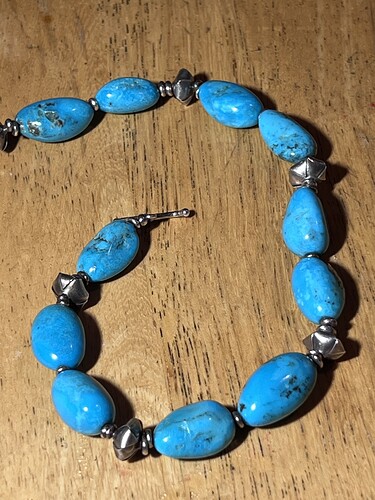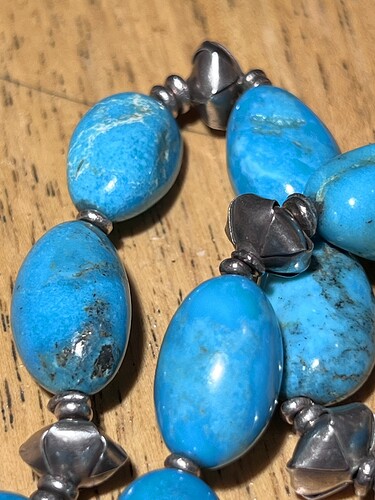Hello, this is my first post on this forum, and I hope to find some help with this item. I bought this from an antique shop in Boston for $30. I have tried acetone and heat test and nothing really happened, but I heard many fake types can easily pass those tests. The whole thing weighs 2.6 oz. I use fluorite to scratch it and while there was white powder traces, they were easily wiped away and the surface looked undamaged. I tried to use a cheap drill to drill into a piece, but it was very hard and the inside wasn’t white, but maybe I didn’t drill deep enough.
I hope the photos and the descriptions were enough. I appreciate any advice.
Welcome. First I would research the types of treatment ranging from Zachary’s to pressurized plastic to dyed howlite. And look at online turquoise example collections of the various mines. There can be a lot of variation from a single mine.
The beads are unique and nothing I’ve seen in NA jewelry but I’m more familiar with vintage. From what I can tell of the clasp it is more typical of Asian manufacture.
Hi Steve,
Thank you so much for your comment. I didn’t know anything about the zachary treatment at all, so this is a great knowledge to have. I would assume that the necklace is Chinese, tho I am not too sure whether if it’s real turquoise or not. I don’t mind Chinese or Zachary turquoise but I hope it’s not plastic nor stabilized grounded stuff.
Welcome to Turquoise People!
If it’s turquoise, I would guess that it’s stabilized, especially since it was only 30.00. Not sure what you mean by “stabilized grounded stuff.” Real turquoise can most definitely be stabilized, but natural turquoise means not stabilized. I have both types in my jewelry.
Agree that it is prob not a Native American piece.
Hi Zia, thank you for replying. Sorry what I meant was reconstituted turquoise, not exactly stabilized turquoise, I suddenly forgot that term at the moment.



